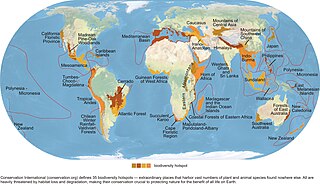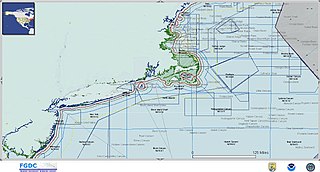Related Research Articles

Urban ecology is the scientific study of the relation of living organisms with each other and their surroundings in an urban environment. An urban environment refers to environments dominated by high-density residential and commercial buildings, paved surfaces, and other urban-related factors that create a unique landscape. The goal of urban ecology is to achieve a balance between human culture and the natural environment.

Land development is the alteration of landscape in any number of ways such as:

Habitat destruction is the process by which a natural habitat becomes incapable of supporting its native species. The organisms that previously inhabited the site are displaced or dead, thereby reducing biodiversity and species abundance. Habitat destruction is the leading cause of biodiversity loss. Fragmentation and loss of habitat have become one of the most important topics of research in ecology as they are major threats to the survival of endangered species.

Human impact on the environment refers to changes to biophysical environments and to ecosystems, biodiversity, and natural resources caused directly or indirectly by humans. Modifying the environment to fit the needs of society is causing severe effects including global warming, environmental degradation, mass extinction and biodiversity loss, ecological crisis, and ecological collapse. Some human activities that cause damage to the environment on a global scale include population growth, neoliberal economic policies and rapid economic growth, overconsumption, overexploitation, pollution, and deforestation. Some of the problems, including global warming and biodiversity loss, have been proposed as representing catastrophic risks to the survival of the human species.

Ecosystem services are the many and varied benefits to humans provided by the natural environment and healthy ecosystems. Such ecosystems include, for example, agroecosystems, forest ecosystem, grassland ecosystems, and aquatic ecosystems. These ecosystems, functioning in healthy relationships, offer such things as natural pollination of crops, clean air, extreme weather mitigation, and human mental and physical well-being. Collectively, these benefits are becoming known as ecosystem services, and are often integral to the provision of food, the provisioning of clean drinking water, the decomposition of wastes, and the resilience and productivity of food ecosystems.

Environmental Impact assessment (EIA) is the assessment of the environmental consequences of a plan, policy, program, or actual projects prior to the decision to move forward with the proposed action. In this context, the term "environmental impact assessment" is usually used when applied to actual projects by individuals or companies and the term "strategic environmental assessment" (SEA) applies to policies, plans and programmes most often proposed by organs of state. It is a tool of environmental management forming a part of project approval and decision-making. Environmental assessments may be governed by rules of administrative procedure regarding public participation and documentation of decision making, and may be subject to judicial review.

Aquatic biomonitoring is the science of inferring the ecological condition of rivers, lakes, streams, and wetlands by examining the organisms that live there. While aquatic biomonitoring is the most common form of biomonitoring, any ecosystem can be studied in this manner.

Environmental planning is the process of facilitating decision making to carry out land development with the consideration given to the natural environment, social, political, economic and governance factors and provides a holistic framework to achieve sustainable outcomes. A major goal of environmental planning is to create sustainable communities, which aim to conserve and protect undeveloped land.

Marine ecosystems are the largest of Earth's aquatic ecosystems and exist in waters that have a high salt content. These systems contrast with freshwater ecosystems, which have a lower salt content. Marine waters cover more than 70% of the surface of the Earth and account for more than 97% of Earth's water supply and 90% of habitable space on Earth. Seawater has an average salinity of 35 parts per thousand of water. Actual salinity varies among different marine ecosystems. Marine ecosystems can be divided into many zones depending upon water depth and shoreline features. The oceanic zone is the vast open part of the ocean where animals such as whales, sharks, and tuna live. The benthic zone consists of substrates below water where many invertebrates live. The intertidal zone is the area between high and low tides. Other near-shore (neritic) zones can include mudflats, seagrass meadows, mangroves, rocky intertidal systems, salt marshes, coral reefs, lagoons. In the deep water, hydrothermal vents may occur where chemosynthetic sulfur bacteria form the base of the food web.

In ecology, resilience is the capacity of an ecosystem to respond to a perturbation or disturbance by resisting damage and recovering. Such perturbations and disturbances can include stochastic events such as fires, flooding, windstorms, insect population explosions, and human activities such as deforestation, fracking of the ground for oil extraction, pesticide sprayed in soil, and the introduction of exotic plant or animal species. Disturbances of sufficient magnitude or duration can profoundly affect an ecosystem and may force an ecosystem to reach a threshold beyond which a different regime of processes and structures predominates. When such thresholds are associated with a critical or bifurcation point, these regime shifts may also be referred to as critical transitions.

DPSIR is a causal framework used to describe the interactions between society and the environment. It seeks to analyze and assess environmental problems by bringing together various scientific disciplines, environmental managers, and stakeholders, and solve them by incorporating sustainable development. First, the indicators are categorized into "drivers" which put "pressures" in the "state" of the system, which in turn results in certain "impacts" that will lead to various "responses" to maintain or recover the system under consideration. It is followed by the organization of available data, and suggestion of procedures to collect missing data for future analysis. Since its formulation in the late 1990s, it has been widely adopted by international organizations for ecosystem-based study in various fields like biodiversity, soil erosion, and groundwater depletion and contamination. In recent times, the framework has been used in combination with other analytical methods and models, to compensate for its shortcomings. It is employed to evaluate environmental changes in ecosystems, identify the social and economic pressures on a system, predict potential challenges and improve management practices. The flexibility and general applicability of the framework make it a resilient tool that can be applied in social, economic, and institutional domains as well.

Marine spatial planning (MSP) is a process that brings together multiple users of the ocean – including energy, industry, government, conservation and recreation – to make informed and coordinated decisions about how to use marine resources sustainably. MSP generally uses maps to create a more comprehensive picture of a marine area – identifying where and how an ocean area is being used and what natural resources and habitat exist. It is similar to land-use planning, but for marine waters.

Earthwatch Institute is an international environmental charity. It was founded in 1971 as Educational Expeditions International by Bob Citron and Clarence Truesdale. Earthwatch Institute supports Ph.D. researchers internationally and conducts over 100,000 hours of research annually. Using the Citizen Science methodology, Earthwatch's mission statement is "to engage people worldwide in scientific field research and education to promote the understanding and action necessary for a sustainable environment." As such, it is one of the global underwriters of scientific field research in archaeology, paleontology, marine life, biodiversity, ecosystems and wildlife. For over forty years, Earthwatch has raised funds to recruit individuals, students, teachers, and corporate fellows to participate in critical field research to understand nature's response to accelerating global change.
Ecosystem-based management is an environmental management approach that recognizes the full array of interactions within an ecosystem, including humans, rather than considering single issues, species, or ecosystem services in isolation. It can be applied to studies in the terrestrial and aquatic environments with challenges being attributed to both. In the marine realm, they are highly challenging to quantify due to highly migratory species as well as rapidly changing environmental and anthropogenic factors that can alter the habitat rather quickly. To be able to manage fisheries efficiently and effectively it has become increasingly more pertinent to understand not only the biological aspects of the species being studied, but also the environmental variables they are experiencing. Population abundance and structure, life history traits, competition with other species, where the stock is in the local food web, tidal fluctuations, salinity patterns and anthropogenic influences are among the variables that must be taken into account to fully understand the implementation of a "ecosystem-based management" approach. Interest in ecosystem-based management in the marine realm has developed more recently, in response to increasing recognition of the declining state of fisheries and ocean ecosystems. However, due to a lack of a clear definition and the diversity involved with the environment, the implementation has been lagging. In freshwater lake ecosystems, it has been shown that ecosystem-based habitat management is more effective for enhancing fish populations than management alternatives.

Study of the environmental impact of war focuses on the modernization of warfare and its increasing effects on the environment. Scorched earth methods have been used for much of recorded history. However, the methods of modern warfare cause far greater devastation on the environment. The progression of warfare from chemical weapons to nuclear weapons has increasingly created stress on ecosystems and the environment. Specific examples of the environmental impact of war include World War I, World War II, the Vietnam War, the Rwandan Civil War, the Kosovo War and the Gulf War.

Environmental issues are disruptions in the usual function of ecosystems. Further, these issues can be caused by humans or they can be natural. These issues are considered serious when the ecosystem cannot recover in the present situation, and catastrophic if the ecosystem is projected to certainly collapse.

Environmental effects of mining can occur at local, regional, and global scales through direct and indirect mining practices. Mining can cause erosion, sinkholes, loss of biodiversity, or the contamination of soil, groundwater, and surface water by chemicals emitted from mining processes. These processes also affect the atmosphere through carbon emissions which contributes to climate change. Some mining methods may have such significant environmental and public health effects that mining companies in some countries are required to follow strict environmental and rehabilitation codes to ensure that the mined area returns to its original state.
The biocapacity or biological capacity of an ecosystem is an estimate of its production of certain biological materials such as natural resources, and its absorption and filtering of other materials such as carbon dioxide from the atmosphere.

Biodiversity loss includes the worldwide extinction of different species, as well as the local reduction or loss of species in a certain habitat, resulting in a loss of biological diversity. The latter phenomenon can be temporary or permanent, depending on whether the environmental degradation that leads to the loss is reversible through ecological restoration/ecological resilience or effectively permanent. The current global extinction, has resulted in a biodiversity crisis being driven by human activities which push beyond the planetary boundaries and so far has proven irreversible.

Human activities affect marine life and marine habitats through overfishing, habitat loss, the introduction of invasive species, ocean pollution, ocean acidification and ocean warming. These impact marine ecosystems and food webs and may result in consequences as yet unrecognised for the biodiversity and continuation of marine life forms.
References
- 1 2 Clark, Ray (1994). "Cumulative effects assessment: A tool for sustainable development". Impact Assessment. 12 (3): 319–331. doi: 10.1080/07349165.1994.9725869 . ISSN 0734-9165.
- 1 2 3 Canter, Larry; Ross, Bill (2010). "State of practice of cumulative effects assessment and management: the good, the bad and the ugly". Impact Assessment and Project Appraisal. 28 (4): 261–268. doi:10.3152/146155110X12838715793200. ISSN 1461-5517. S2CID 128882154.
- ↑ Duinker, Peter N.; Burbidge, Erin L.; Boardley, Samantha R.; Greig, Lorne A. (October 26, 2012). "Scientific dimensions of cumulative effects assessment: toward improvements in guidance for practice". Environmental Reviews. 21 (1): 40–52. doi:10.1139/er-2012-0035. ISSN 1181-8700.
- ↑ Reid, Leslie; Lisle, Tom (May 20, 2008). "Cumulative Effects and Climate Change | Climate Change Resource Center". www.fs.usda.gov. Retrieved 2019-04-09.
- 1 2 3 Connelly, Robert (Bob) (2011). "Canadian and international EIA frameworks as they apply to cumulative effects". Environmental Impact Assessment Review. 31 (5): 453–456. doi:10.1016/j.eiar.2011.01.007.
- 1 2 3 4 5 6 Clarke Murray, Cathryn; Mach, Megan; Martone, Rebecca (2014). "Cumulative effects in marine ecosystems: scientific perspectives on its challenges and solutions". WWF-Canada and Center for Ocean Solutions.
- ↑ Hoban, Christopher; Tsunokawa, Koji (1997). Roads and the Environment: A Handbook. The World Bank. doi:10.1596/r12. ISBN 9780821321645.
- ↑ Renilson, Martin (2007). "A Note on Some Important Marine Environmental Issues". The Journal of Ocean Technology. 2: 68–81.
- ↑ Stelzenmüller, V; Lee, J; South, A; Rogers, SI (2010-01-05). "Quantifying cumulative impacts of human pressures on the marine environment: a geospatial modelling framework". Marine Ecology Progress Series. 398: 19–32. Bibcode:2010MEPS..398...19S. doi: 10.3354/meps08345 . ISSN 0171-8630.
- ↑ ROSENBERG, DAVID M.; MCCULLY, PATRICK; PRINGLE, CATHERINE M. (2000). "Global-Scale Environmental Effects of Hydrological Alterations: Introduction". BioScience. 50 (9): 746. doi: 10.1641/0006-3568(2000)050[0746:gseeoh]2.0.co;2 . hdl: 1993/33953 . ISSN 0006-3568.
- ↑ McCartney, Matthew (2009). "Living with dams: managing the environmental impacts". Water Policy. 11 (S1): 121–139. doi:10.2166/wp.2009.108. hdl: 10568/21494 . ISSN 1366-7017.
- 1 2 Dincer, Ibrahim (1999). "Environmental impacts of energy". Energy Policy. 27 (14): 845–854. doi:10.1016/s0301-4215(99)00068-3. ISSN 0301-4215.
- 1 2 Theobald, David M.; Miller, James R.; N. Thompson, Hobbs (1997). "Estimating the cumulative effects of development on wildlife habitat". Landscape and Urban Planning. 39: 25–36. doi:10.1016/S0169-2046(97)00041-8.
- ↑ Clevenger, Anthony; van der Grift, Edgar; Jaeger, Jochen A. G.; van der Ree, Rodney (2011-03-29). "Effects of Roads and Traffic on Wildlife Populations and Landscape Function: Road Ecology is Moving toward Larger Scales". Ecology and Society. 16 (1). doi: 10.5751/ES-03982-160148 . ISSN 1708-3087.
- ↑ Van Adams, Arvil; Stevenson, Gail; Kelly, Terence; Noss, Andrew; Regel, Omporn; Yoon, Yang-Ro (1997). World Bank Technical Papers. The World Bank. doi:10.1596/r12. ISBN 9780821321645.
- ↑ Cooper, Lourdes M.; Sheate, William R. (2002). "Cumulative effects assessment". Environmental Impact Assessment Review. 22 (4): 415–439. doi:10.1016/S0195-9255(02)00010-0.
- 1 2 3 4 5 6 7 8 Clark, Ray (1994). "Cumulative Effects Assessment: A Tool for Sustainable Development". Impact Assessment. 12 (3): 319–331. doi: 10.1080/07349165.1994.9725869 . ISSN 0734-9165.
- ↑ Parkins, John; Mitchell, Ross (2011-06-30). "The Challenge of Developing Social Indicators for Cumulative Effects Assessment and Land Use Planning". Ecology and Society. 16 (2). doi: 10.5751/ES-04148-160229 . hdl: 10535/7606 . ISSN 1708-3087.
- ↑ Durden, Jennifer M.; Lallier, Laura E.; Murphy, Kevin; Jaeckel, Aline; Gjerde, Kristina; Jones, Daniel O.B. (January 2018). "Environmental Impact Assessment process for deep-sea mining in 'the Area'". Marine Policy. 87: 194–202. doi: 10.1016/j.marpol.2017.10.013 . hdl: 1854/LU-8536551 .
- 1 2 Ma, Zhao; Becker, Dennis R.; Kilgore, Michael A. (2012). "Barriers To And Opportunities For Effective Cumulative Impact Assessment Within State-Level Environmental Review Frameworks In The United States". Journal of Environmental Planning & Management. 55 (7): 961–978. doi:10.1080/09640568.2011.635013. S2CID 783012.
- 1 2 Eccleston, Charles H. (2008). NEPA and Environmental Planning: Tools, Techniques, and Approaches for Practitioners. Chapter 9. CRC Press. ISBN 9780849375590.